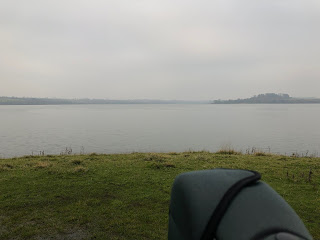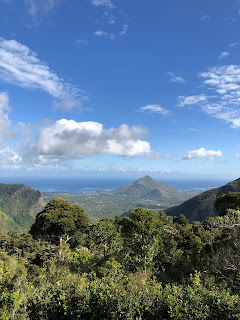5-Grebe-Day
New Years’ Day is my favourite day to bird. At no other time of year would you get a line of 20 birders at Rutland Water all desperately trying to glimpse a single male Siskin in a flock of Goldfinch. Whether you’re trying for a big year list or not, it’s hard not to catch the New Years’ Day bug.
Arriving just after first light, my dad and I began at the North Arm, which is best viewed from the end of the road to the Warden’s Cottage, north off the road to Upper Hambleton. This is signed as a private road, but Tim Appleton is happy for birders to use it to view the arm (and his feeders, which had Coal Tit, Long-tailed Tit, Nuthatch and Marsh Tit while we were there). In the North Arm were the best views of 2 Black-Necked Grebes and a Slavonian Grebe that I’ve had here, and Dad managed to find a female-type Scaup in amongst the Tufted Ducks.
 |
| Viewing from Old Hall in the direction of Manton Bay - the Red-Necked Grebe was found here |
Moving onto Old Hall, we’d already developed a healthy list which included Great White Egret– a bird which, only a few years ago, would have been the bird of the morning. These colonists seemed to be even more common than Little Egrets on our visit today.
Old Hall was a new area for me – on my visits in recent winters there has usually been a Red-Necked Grebe wintering in South Arm III (sometimes seen from Lapwing Hide) but extensive searching from Lapwing Hide has never been successful. This year I made the effort to try Old Hall from which it’s usually reported and this came up trumps. The grebe was the first bird I saw– relatively close in and in the direction of Manton Bay. Despite always moving, it stayed in this general area, explaining why I could never have seen it from Lapwing Hide, since I could barely see the hide itself (perhaps there’s an outside chance of seeing it from Fieldfare or Gadwall Hide). My last Red-Necked Grebe was here in 2011 from the Lyndon Reserve so this was an exciting bird for me – I was struck by how visibly different it was from a Great-Crested Grebe when seen well.
 |
| Slavonian Grebe |
 |
| Red-Necked Grebe |
 |
| Black-Necked Grebe |
By 10:00 we had already made it a 5-grebe-day – impressive anywhere let alone on an inland reserve!
Round to Egleton NR now, where we birded the northern hide group – this is one of my favourite places to bird; there are so many hides, always something to see and one of those reserves where anything could turn up. We visited nearly all of the hides – but lagoon 4 was surprisingly quiet (possibly due to the water level) - and the highlights were finding a brief Black-tailed Godwit on Lagoon 1 (possibly the first for the reserve since October) Red-Crested Pochard (Lapwing Hide), finding 3 more female-type Scaup from Lapwing, Smew (all females sadly, on Lagoons 1&4), Lesser Redpoll, Siskin, Stonechat, Goosander, Snipe and Golden Plover. Smew tend to commute between here and Eyebrook Reservoir so it’s essentially up to luck how many will be here on any one day. Rutland and Eyebrook are such reliable sites for this species – I have never missed them on a winter visit – which is so scarce elsewhere.
 |
| I have yet to miss Smew here on a winter visit |
We thought we’d give the southern hides a look in case we could find a Merlin that had been seen or perhaps some more waders. I rarely visit these hides but they can turn up good birds, though after a loop round the first 5 hides we had only added Marsh Harrier on Lagoon 1 so headed to Lyndon NR instead.
The day was getting on as we arrived at Lyndon NR, adding Redwing, Linnet and Greenfinch in quick succession which could have been disappointing misses. We had a look from Teal Hide for the reported Ruddy Shelducks or escaped female Bufflehead but had no luck in the fading light. The gull roost was spectacular, and with more time to scan surely something interesting could have been picked out.
Instead, we watched the visitor centre feeders from the path where Marsh Tits are regular and a Willow Tit (a rare bird for Rutland) had been seen lately. Eventually, a Marsh/Willow Tit showed in a tree a few metres away from us, and just as we were trying to work out how we could diagnose the species in the half-light it solved our dilemma and called. Willow Tit – making a nice end to a busy day.
This moved the day list to 79 species – not bad for a day list on a single reserve in the middle of winter. Sadly, no owls on the journey home obliged to take us up to a nice round 80, so 79 is where the day list finished - including 14 species of duck, 7 finches, 6 tits and best of all 5 grebes.




Comments
Post a Comment